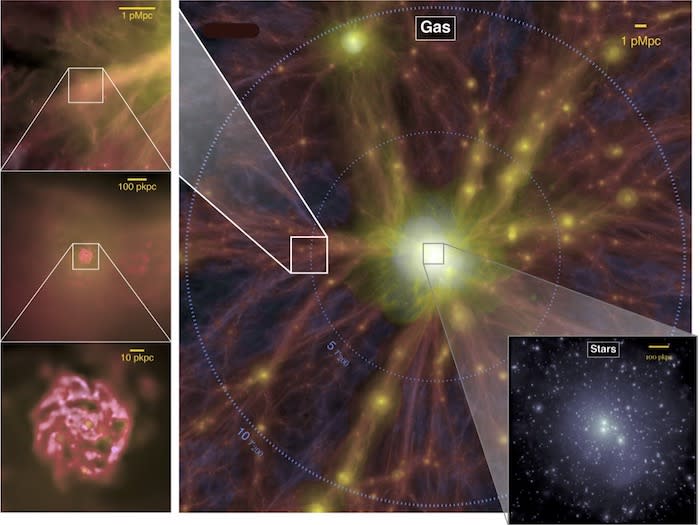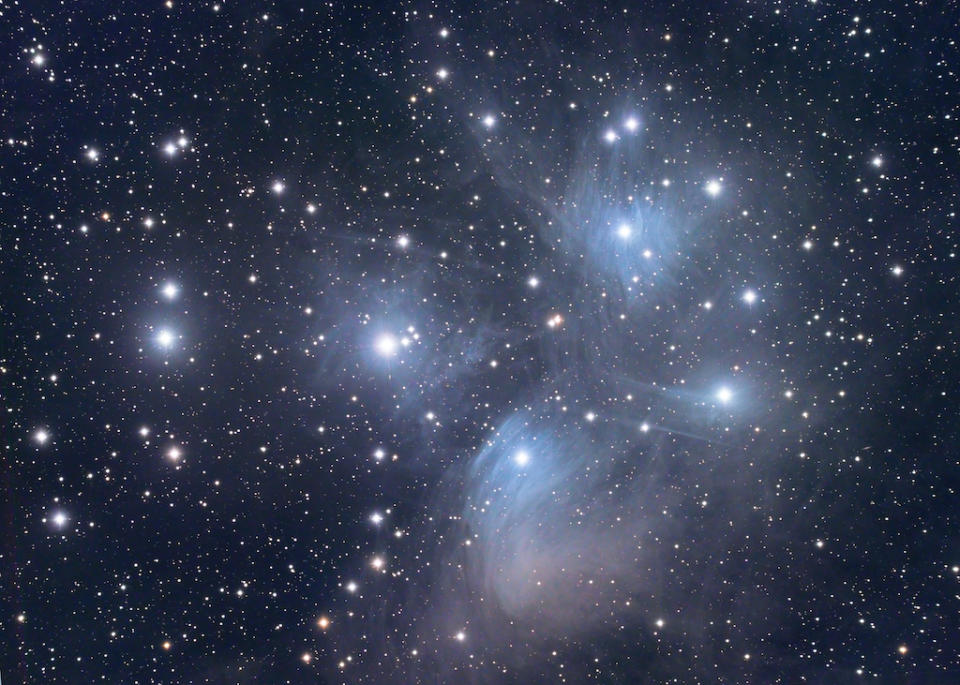How do galaxies grow while ensnared in the universe's cosmic web?

Just like being trapped within a spider's web drastically changes a fly's life, galaxies ensnared in the vast cosmic web are dramatically and irreversibly altered.
Now, scientists from the University of Kansas are aiming to better understand the mechanisms at play in shaping clusters of galaxies as they travel through a cosmic web of different environments.
KU professor of physics and astronomy Gregory Rudnick is leading the effort, which involves recreating the cosmic web in a computer simulation, then studying gas content and star-formation properties of galaxies as they move through that web. The effort will use images of around 14,000 galaxies from the DESI Legacy Survey, the Wide-field Infrared Survey Explorer (WISE) and NASA's Galaxy Evolution Explorer (GALEX); The team will collect additional observations with Siena's 0.7-m Planewave telescope.
"The primary objective of this project is to comprehend the impact of environmental factors on the transformation of galaxies," Rudnick said in a statement. "In the universe, galaxies are spread in a non-uniform distribution characterized by varying densities. These galaxies aggregate into large clusters, comprising hundreds to thousands of galaxies, as well as smaller groups, consisting of tens to hundreds of galaxies."
Related: The mystery of vast 'cosmic ORCs' — odd radio circles that encompass entire galaxies — may be solved
Galaxies can sit in clusters or groups, or they may dwell in more isolated, lower-density regions of the universe called "the field," Rudnick pointed out.
Whereas previous studies that simulated the cosmic web and galaxies within have compared galaxies in clusters and groups to those alone in the field, they have neglected to factor in elongated filamentary structures of gas, dust and stars that connect the clustered kind.
Rudnick and colleagues factored in this cosmic highway, focusing on the filamentary environments galaxies encounter, how the galaxies are channeled into groupings and clusters in the first place, and how the filaments affect their evolution.
"Galaxies follow a path into these filaments, experiencing a dense environment for the first time before progressing into groups and clusters," Rudnick said. "Studying galaxies in filaments allows us to examine the initial encounters of galaxies with dense environments."

Most galaxies that enter the "urban centers" of clusters, Rudnick added, do so along cosmic web "superhighways," with a small number taking "rural routes" that bring them into the clusters and groups without interacting much with their surroundings.
"Whereas filaments are akin to interstate highways, these less-traveled routes into dense regions are akin to the analogy of driving on rural roads in Kansas to access city limits," Rudnick said. "Galaxies can exist in filaments or be in groups that reside in filaments like beads on a string. Indeed, most galaxies in the universe exist within groups."
The team hopes that, with this simulation, it'll be possible to glean insight into the onset of environmental effects on galaxies and to decode how galaxies behave in the filaments and groups where they are most commonly found.
Trapped galaxies birthing stars
One key aspects of the work undertaken by the KU team will be to assess how conditions of the cosmic web filaments affect the processing of gas in pockets of overdensity, which scientists call the "baryon cycle."
Because stars are born when overly dense clumps of gas and dust collapse, disruptions of the baryon cycle can either boost or hinder star formation, thus increasing or slowing the growth of galaxies.
"The space between galaxies contains gas. Indeed, most of the atoms in the universe are in this gas, and that gas can accrete onto the galaxies," Rudnick said. "This intergalactic gas undergoes a transformation into stars, although the efficiency of this process is relatively low, with only a small percentage contributing to star formation. The majority is expelled in the form of large winds."
Some of these winds become outflows that blow from galaxies back into space, while other wind-blown matter falls back to its galaxy of origin, is accreted and finally recycled as part of the baryon cycle.
"Galaxies can be conceptualized as baryon processing engines, drawing gas from the intergalactic medium and converting some of it into stars," Rudnick explained. "Stars, in turn, go supernova, producing heavier elements. Part of the gas is blown out into space, forming a galactic fountain that eventually falls back to the galaxy.”

When galaxies encounter a dense environment on the cosmic web, they can change their internal pressure and disrupt the baryon cycle by actively stripping gas from the galaxy or depriving it of its future gas supply.
This results in galactic star factories, that sit at the hearts of clusters, slowing to a halt as their raw, star-birthing material is quenched.
"The disruption affects the intake and expulsion of gas by galaxies, leading to alterations in their star formation processes," Rudnick said. "While there may be a temporary increase in star formation, in nearly all cases, it eventually results in a decline in star formation."
Related Stories
—Record-breaking radio burst could help us find the universe's missing matter
—Light from the cosmic web connecting galaxies has been seen for the 1st time (video)
The team's simulations will hopefully help scientists better understand the baryon cycle, something which was highlighted as a key science topic for the coming decade by the Astro2020 Decadal survey.
The research will also include science outreach to Kansas and New Jersey high school students through 2026. This will include equipping schools with 11 MacBook Pros to allow students to engage with the research project.

